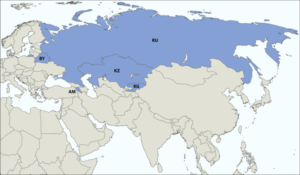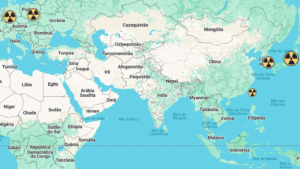The European Commission – the executive arm of the Union – adopted on July 14, 2021 a package of proposals aimed at preparing and enabling the European Union’s (EU) climate, energy, land use, transport, and tax policies to achieve a reduction in net greenhouse gas emissions of at least 55 percent by 2030, the so-called “Fit for 55,” compared to 1990 levels.
According to the EU, achieving these emission reductions in the next decade is key to making Europe the first climate-neutral continent by 2050 and making the European Green Deal a reality.

With the unveiled proposals, the Commission is putting forward the legislative instruments needed to meet the targets agreed upon in the European Climate Act and to fundamentally transform Europe’s economy and society for a less unequal, greener and more prosperous future.
A comprehensive and interlinked set of climate measures proposals
The proposals put forward by the EU combine:
- applying carbon emissions trading to new sectors
- strengthening the existing EU Emissions Trading System
- increasing the use of energy from renewable sources
- increasing energy efficiency
- more rapid deployment of low-emission transport modes and the infrastructure and fuels to support them
- aligning tax policies with the goals of the European Green Deal
- measures to prevent carbon leakage
- instruments to preserve and enhance natural carbon sinks in the EU.
What is the context of the European Green Pact?
The European Green Pact, presented by the Commission on December 11, 2019, sets the goal of making Europe the first climate-neutral continent by 2050.
The European Climate Act, which comes into force this month, enshrines in binding legislation the EU’s commitment to climate neutrality and the interim target of reducing net greenhouse gas emissions by at least 55 percent by 2030 compared to 1990 levels.
What results have been achieved so far?
As a result of the EU’s current climate and energy legislation, the EU’s greenhouse gas emissions have already fallen by 24% compared to 1990, while the EU economy has grown by more than 60% over the same period, decoupling growth from emissions.
What are the potential benefits for Europe and the planet?
The benefits of immediate action to protect people and the planet are relatively obvious: cleaner air, cooler and greener cities, healthier citizens, lower energy consumption and bills, job creation in Europe, opportunities for European technologies and industrial sectors, more space for nature, and a healthier planet to leave to future generations.
What are the main challenges for implementing Europe’s green package?
The central challenge of Europe’s green transition is to ensure that the benefits and opportunities it brings are available to all, as quickly and as equitably as possible.
In addition, the “Fit for 55,” as the package being launched is called, will face months of negotiations between the 27 EU countries and the European Parliament as they need to approve the proposals.
Invariably, these negotiations to pass the package, will also come under pressure from corporate interest groups, so-called “lobbying.”
The plans have already exposed familiar divisions between the richer Western European states and the Nordic countries where electric vehicle sales are skyrocketing and the poorer Eastern countries that are concerned about the social cost of bringing their economies out of the coal age.
Why is this gigantic climate package from the European Union important?
The policies, if approved, would put the European bloc – the world’s third largest economy – on track to meet its 2030 target of reducing global warming emissions by 55% from 1990 levels.
Since the European Union, because of its size and importance, has a large normative role in the world – to create and spread norms that will be followed by other countries – what happens there can be followed and spread to the rest of the world.
Other major economies, including China and the United States – the world’s two largest emitters of greenhouse gases – have committed to achieving zero net emissions in the coming decades, which scientists say is necessary for the entire world to achieve by 2050 to avoid catastrophic levels of climate change.
Thus, as a pioneer in the fight against climate change, the European Union is the world’s leading actor in this area and a potential leader of an economic and social revolution to avoid a climate tragedy in the coming decades.
In geopolitical terms, the European Ecological Pact strengthens the “strategic autonomy” of the European Union
Currently, the vast majority of hydrocarbons used to produce energy, heating, and transportation in Europe are imported from Russia and the Middle East.
For historical and geopolitical reasons, these suppliers are unreliable in the eyes of the European Union and can hold it hostage as in the case of the OPEC oil shocks and the use of gas as part of Russia’s hybrid war arsenal against the European continent.
Thus, a migration of the economy and society from the use of oil and gas (and coal) to renewable energy sources will strengthen “strategic autonomy” in the EU, strengthening the bloc domestically and in its international relations.
The quest for the bloc’s “strategic autonomy” became a fundamental part of European geopolitical doctrine after the bloc experienced supply difficulties during the Covid-19 pandemic.
More specifically about each of the 13 directives and regulations in the European Union’s climate package
1- The EU Emissions Trading System (ETS) sets a price on carbon and reduces the cap on emissions from certain economic sectors every year.
A carbon tax has succeeded in reducing emissions from energy production and energy-intensive industries by 42.8 percent over the past 16 years.
The Commission proposes to lower the overall emissions cap even further and increase its annual reduction rate. The Commission also proposes to phase out free allowances for aviation and align with the International Aviation Carbon Offsetting and Emissions Reduction Scheme (CORSIA), and to include emissions from shipping for the first time in the ETS.
To address the lack of emission reductions in road transport and buildings, a new separate emissions trading system will be established for fuel distribution for road transport and buildings. The Commission also proposes to increase the size of the innovation and modernisation funds.
2- Member States should spend all their revenues from emissions trading on climate and energy related projects.
A specific part of the revenues from the new system dedicated to road transport and buildings should address the possible social impact on vulnerable households, micro-enterprises and transport users.
3- The Effort Sharing Regulation gives each Member State enhanced emission reduction targets for buildings, domestic road transport and shipping, agriculture, waste and small industries.
Reflecting the different starting points and capabilities of Member States, these targets are based on GDP per capita and are adjusted for cost efficiency.
4- Member States also share responsibility for removing carbon from the atmosphere, so the Land Use, Land Use Change and Forestry Regulation sets an overall EU target for carbon removal by natural sinks by 2030, equivalent to 310 million tons of CO2 emissions.
Meeting the national targets will require Member States to preserve and expand their carbon sinks. By 2035, the EU should aim to achieve climate neutrality in the land use, forestry and agriculture sectors, also including non-CO2 agricultural emissions such as those from fertilizer use and animal husbandry.
The EU Forest Strategy aims to improve the quality, quantity and resilience of EU forests. It supports foresters and the forest-based bio-economy, while maintaining the sustainability of biomass extraction and use, preserving biodiversity, and setting out a plan to plant three billion trees across Europe by 2030.
5- The Renewable Energy Directive will set an enhanced target of 40% of energy production from renewable sources by 2030.
Energy production and use accounts for 75% of EU emissions and it is crucial to accelerate the transition to a greener energy system.
All Member States will contribute to this goal, with specific targets proposed for the use of renewable energy in transport, heating and cooling, buildings and industry.
To meet these climate and environmental objectives, the sustainability criteria for the use of bioenergy are strengthened and any bioenergy support schemes designed by Member States must respect the principle of cascading woody biomass.
6- The Energy Efficiency Directive will set a more ambitious binding annual target for reducing energy consumption at EU level in order to reduce overall energy consumption, cut emissions and tackle energy poverty
It will guide how national contributions are set and almost double the annual energy savings obligation for Member States.
The public sector will have to renovate 3% of its buildings annually in order to drive the wave of renovation, create jobs and reduce energy consumption and costs for taxpayers.
7- Stricter CO2 emission standards for passenger cars and light commercial vehicles.
These rules will accelerate the transition to zero-emission mobility by requiring average emissions from new cars to fall by 55 percent from 2030 and by 100 percent from 2035 compared to 2021 levels.
According to the EU, a combination of measures to combat rising emissions in road transport is needed to complement emissions trading. As a result, all new cars registered from 2035 will have zero emissions.
8- The revised Alternative Fuel Infrastructure Regulation will require Member States to increase battery charging capacity.
This increase must be in line with sales of zero-emission cars and install charging and refuelling points at regular intervals on major freeways: every 60 km for electric charging and every 150 km for hydrogen refuelling.
This will ensure that drivers can recharge or refuel their vehicles on a reliable network throughout Europe.
9- The ReFuelEU Aviation Initiative will oblige fuel suppliers to blend increasing levels of sustainable aviation fuels into aviation engine fuel supplied on board EU airports, particularly low-carbon synthetic fuels known as “e-fuels.”
This initiative is part of the Alternative Fuels Infrastructure Regulation that requires aircraft and ships to have access to clean electricity supplies at major ports and airports in the Union.
10- Similarly, the FuelEU Maritime Transport Initiative, will encourage the use of sustainable marine fuels and zero-emission technologies.
It will do this by setting a cap on greenhouse gas content for energy used by ships calling at European ports.
Aviation and marine fuels cause significant pollution and also require specific measures to complement emissions trading.
11- A revision of the Energy Taxation Directive proposes to align the taxation of energy products with EU energy and climate policies.
The aim is to promote clean technologies and remove obsolete exemptions and reduced rates that currently encourage the use of fossil fuels.
Taxation of energy products should safeguard and enhance the European single market and support the ecological transition by providing the right incentives.
The new rules aim to reduce the harmful effects of tax competition in the energy sector by helping to secure revenues for Member States from environmental taxes, which are less harmful to growth than taxes on labor.
12- A new border carbon adjustment mechanism will put a price on carbon in imports of a specific selection of products.
The aim is to ensure that Europe’s ambitious climate action does not lead to “carbon leakage” where European companies export production from Europe to polluting countries, and then import the finished products, but which have emitted large amounts of pollutants to be produced.
Such a mechanism will ensure that the reduction in European emissions contributes to a reduction in global emissions, rather than encouraging carbon-intensive production outside of Europe.
Such a mechanism also aims to encourage industry outside the EU and Europe’s international partners to take action in the same direction.
13- Creating a new Social Fund for Climate Action
Carbon pricing instruments generate revenue that can be reinvested to stimulate innovation, economic growth and investments in clean technologies.
The aim of the Social Climate Action Fund is to make specific funding available to Member States to help people finance investments in energy efficiency, new heating and cooling systems, and greener mobility.
The Social Climate Action Fund would be financed from the EU budget, using an amount equivalent to 25% of the expected revenues from emissions trading on fuels for buildings and road transport.































[…] the factors that influence the possibility of enlargement of the European Union in the Balkans […]